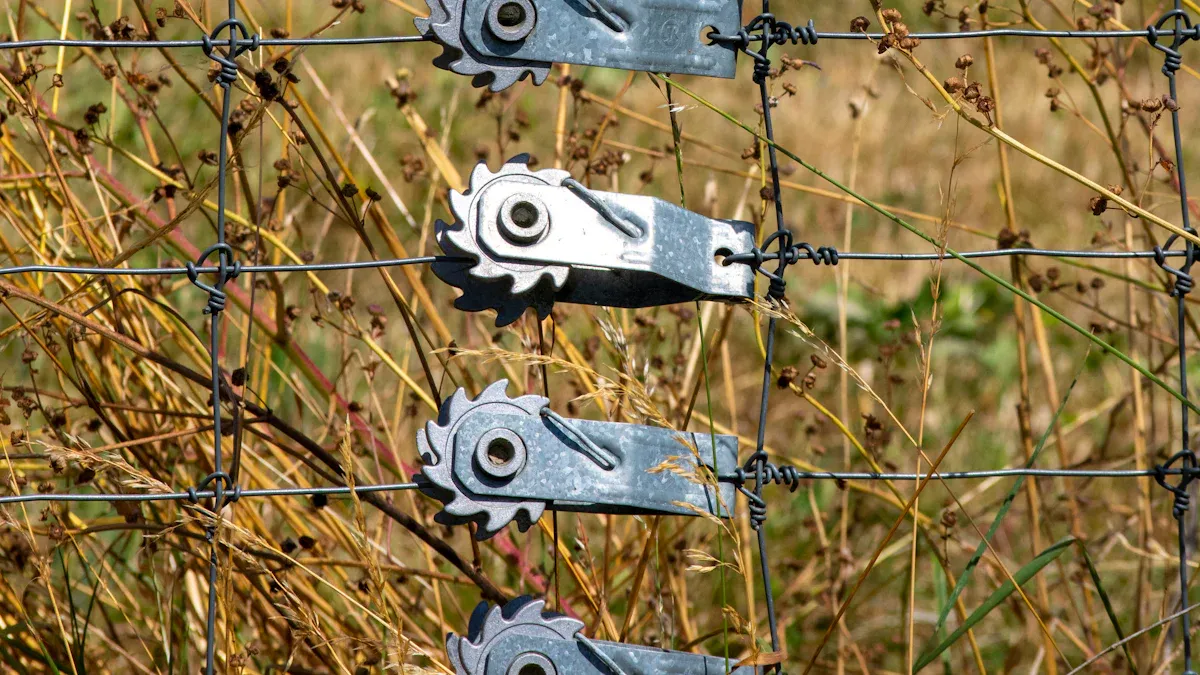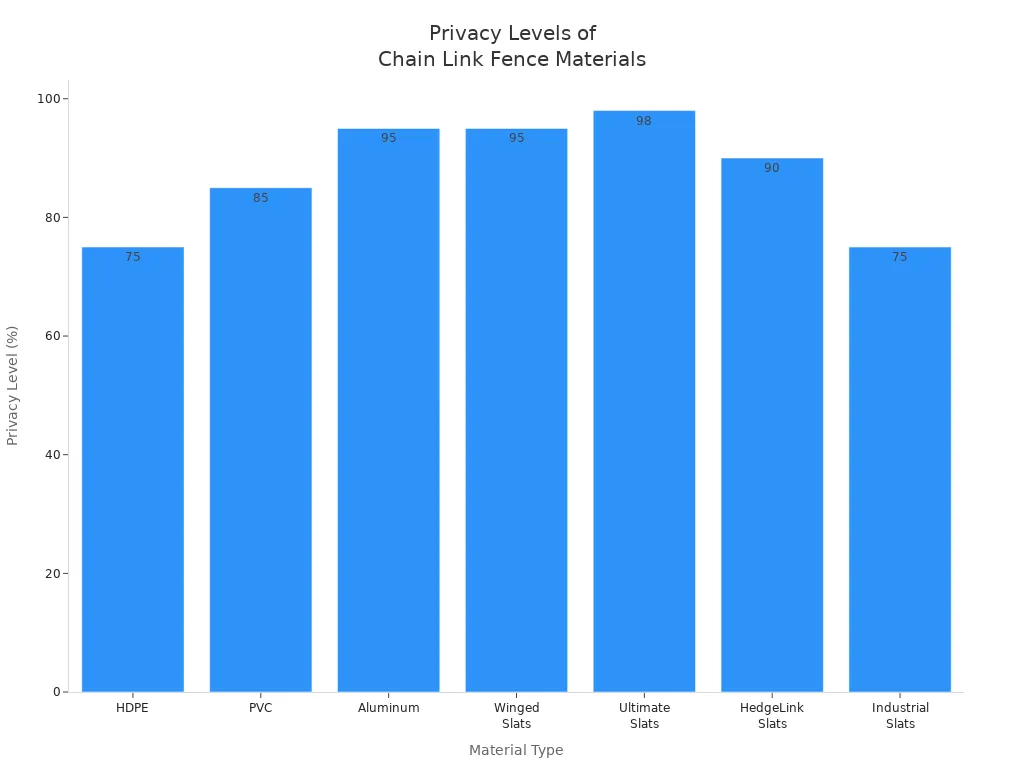Outdoor Storage
Views: 0 Author: Site Editor Publish Time: 2025-09-12 Origin: Site









Chain link fence owners take care of their fences by looking for damage, washing with gentle soap, and fixing rusty spots. Regular care keeps the fence nice and helps it stay strong for years. Chain link fencing is found in many places, like houses and stores, and makes up about 34% of all fences in the United States. Easy steps, like looking for loose parts and bent poles, make taking care of the fence simple for everyone.
Regularly inspect your chain link fence for damage. Look for rust, sagging, and loose parts to prevent bigger issues later.
Clean your fence at least once a year using mild soap and water. This keeps it looking good and helps it last longer.
Treat rust quickly with vinegar or baking soda. Apply a rust-resistant primer and paint to protect your fence from future damage.
Perform minor repairs promptly. Fix holes and tighten loose posts to maintain the fence’s strength and appearance.
Prepare your fence for winter by using rust-proof spray and clearing away debris. This helps prevent damage from snow and ice.

Image Source: pexels
Chain link fencing is used in cities and in the country. People pick this fence because it is strong and does not cost a lot. It is also simple to put up. The next parts talk about the main ways people use chain link fencing.
Chain link fencing marks property lines and keeps out people who should not be there. Construction sites use these fences to stop people from getting in and stealing tools. Sports fields and parking lots use chain link fencing for safety and to show where the area ends. You can add privacy slats or barbed wire to make the fence safer and harder to see through. Chain link fencing lets you look through it, so it is easier to watch what is happening.
Tip: Chain link fencing keeps places safe and lets you see through it, which is good for watching over an area.
Families use chain link fencing to make safe places for kids and pets. This fence keeps pets in the yard so they do not run away. It also keeps children safe by blocking off pools or gardens. Chain link fences are tough and most pets cannot break them. The 11½ gauge chain link fabric is strong but not too heavy, so it works well for homes.
Backyard enclosures
Pet containment
Pool protection
People who plan events use chain link fencing to control crowds. These fences are easy to put up and take down. They help keep big groups in order and make sure everyone stays safe by showing where people can go. Chain link fencing is hard to climb, so it helps keep events safer.
Gardeners use chain link fencing to keep animals away from plants and to help plants grow up the fence. Some people use it as a trellis for vegetables or flowers. In the country, chain link fencing keeps animals in and shows where land starts and ends. Some people add privacy slats or decorations to make their fence look nicer.
| Fencing Material | Cost per Linear Foot | Cost Comparison |
|---|---|---|
| Chain link | $5 to $20 | More budget-friendly |
| Wood | Higher than chain link | More expensive |
| Vinyl | Higher than wood | More expensive |
Chain link fencing is a smart and cheap choice for many jobs. It works for short-term and long-term needs. That is why many homes, businesses, and public places use it.

Image Source: unsplash
Regular inspection helps keep chain link fencing strong and safe. People should walk around the fence and look closely at each section. They need to check the chain link fabric for holes, loose wires, or sagging. The chain link framework, including posts and rails, must stand straight and show no bends or dents. Chain link gates should open and close smoothly without sticking or dragging. Shaking the fence gently can reveal weak spots or instability.
| Common Signs of Wear or Damage | Description |
|---|---|
| Rust | Moisture causes rust, which weakens metal parts. |
| Sagging | Drooping happens when tension wires or posts lose strength. |
| Bent Framework | Wind, impacts, or age can bend posts and rails. |
| Issues with Gates | Gates may stick or not latch properly if damaged. |
Tip: Early detection of rust, sagging, or bent chain link fabric and framework prevents bigger problems later.
Cleaning chain link fencing keeps it looking good and helps it last longer. People should clean the fence at least once a year. Water and mild soap work well for removing dirt and debris from chain link fabric. A high-pressure hose can help with stubborn grime. For tough spots, scrubbing with a wire brush or steel wool removes buildup. Chain link gates also need cleaning to prevent dirt from blocking hinges or latches.
Use a broom to clear away leaves and loose debris.
Wash chain link fabric with soapy water and rinse well.
Spray with a high-pressure hose for deep cleaning.
Scrub rusty areas with vinegar and let it sit for 30-45 minutes before rinsing.
Note: Regular cleaning stops grime and organic material from building up on chain link fencing.
Rust weakens chain link fencing and shortens its life. People should inspect the fence often, especially in humid or coastal areas. Removing rust quickly helps protect the chain link fabric and framework. Vinegar and baking soda work well for treating small rust spots. After cleaning, applying a metallic anti-rust paint restores strength and prevents future rust. Using a paint roller or brush ensures even coverage. Adding a protective coating to chain link fabric and framework gives extra protection.
Inspect chain link fencing for rust every few months.
Remove rust with vinegar or baking soda.
Apply a rust-resistant primer and let it dry before painting.
Use metallic anti-rust paint for long-lasting results.
Tip: Vinyl-coated chain link fencing resists rust better than plain metal.
Minor repairs keep chain link fencing secure and looking neat. Fixing holes in chain link fabric involves trimming frayed edges and attaching new wire mesh. Tightening loose posts stops sagging and keeps the chain link framework stable. Chain link gates may need hinge adjustments or latch replacements. Common tools for repairs include pliers, wire cutters, a wrench, a tension bar, and tie wires. Most minor repairs cost $10 to $20 per linear foot and take a few hours to complete.
Trim damaged chain link fabric and attach new mesh.
Tighten posts and rails to prevent sagging.
Adjust chain link gates for smooth operation.
Sand down rust spots and apply protective coatings.
| Repair Task | Tools Needed | Average Cost | Time Required |
|---|---|---|---|
| Fixing holes | Pliers, wire cutters | $10-$20/ft | Few hours |
| Tightening posts | Wrench, tension bar | $10-$20/ft | Few hours |
| Treating rust | Wire brush, paint | $10-$20/ft | Few hours |
Note: Quick repairs stop small problems from turning into expensive fixes.
Winter is cold and brings snow and ice. These things can hurt chain link fences. People should get their fences ready before winter starts. If the fence does not have a vinyl coating, use a rust-proof spray. This spray helps stop rust from growing on chain link wires and chain link fittings. Make sure all fasteners are tight. Check that the fence is pulled tight so it does not sag or bend when snow gets heavy. Take away plants and leaves near the fence. This keeps water away and helps stop freezing damage. Many people with commercial chain link fences look for loose parts before winter. These steps help both temporary and permanent fencing stay safe in bad weather.
Use rust-proof spray on metal that is not covered.
Tighten fasteners and tension wires.
Clear away plants and trash near the fence.
Check posts and rails to make sure they are steady.
Tip: Getting a fence ready for winter can save money on repairs in spring.
| Seasonal Factor | Impact on Chain Link Fences |
|---|---|
| UV Exposure | Sunlight can slowly break down the fence material. |
| Humidity | Wet air can cause rust and damage, especially on metal fences. |
| Moisture | Too much water makes rust worse if the coating is broken. |
| Salt in the Air | Salt near the ocean makes metal parts rust faster. |
| Wind and Storms | Strong wind can push on the fence and cause damage. |
| Soil Conditions | Bad soil can make fences lean or sink if not put in right. |
Spring and summer are good times to check and clean chain link fences. Look for rust and use rust-resistant paint or spray to stop it from spreading. Fix broken links and straighten any bent spots. Keep vines and plants away from the fence. This stops them from pulling on chain link wires. Wash the fence with water, dish soap, and a brush to get rid of dirt. This keeps the fence looking nice. Do not climb on the fence. Climbing can bend the support rails. People who own commercial chain link fences often check their fences during these months to keep them safe and looking good.
Look for rust and fix rusty spots.
Replace broken links and fix bent parts.
Keep plants away from the fence.
Wash with water, soap, and a brush.
Do not climb on the fence.
Note: Taking care of chain link fences in spring and summer helps them last longer and stay strong.
Sometimes, chain link fences have big problems. Large holes in the chain link fabric make the fence unsafe. Heavy rust and corrosion can weaken chain link wires and chain link fittings. If posts bend or lean, the fence may lose its shape. When many parts are damaged, fixing it alone is hard. Uneven ground or rocky soil makes repairs even tougher. Commercial chain link fences often get these problems after storms or lots of use. If you do not know how to fix temporary or permanent fencing, call a professional. Professionals can fix these big problems fast and safely.
Tip: If you see big holes, lots of rust, or leaning posts, a professional can make the fence safe and look good again.
| Type of Replacement | Average Cost |
|---|---|
| Fabric | $70 - $350 |
| Gate | $90 - $250 |
| Post | $175 - $400 |
| Top Rail | $200 - $450 |
| Size | Average Repair Cost |
|---|---|
| 25 Linear Feet | $200 - $500 |
| 50 Linear Feet | $400 - $1,000 |
| 100 Linear Feet | $800 - $2,000 |
Picking a good chain link fence repair service is important. Look for contractors with the right license and insurance. A license means the installer follows local rules. Insurance keeps you safe if something goes wrong. Skilled workers know how to fix chain link wires and chain link fittings. A good reputation comes from happy customers and good reviews. Good customer service means the contractor listens and helps you. Clear prices help you avoid surprise costs. Many commercial chain link fence owners pick companies with lots of experience.
| Criteria | Description |
|---|---|
| Licensing | Most states want fencing installers to have a license. This helps make sure the work is good. |
| Insurance | Insurance keeps you and your property safe during repairs. |
| Experience | Skilled contractors know what problems might happen and how to fix them. |
| Reputation | Good reviews and recommendations show the contractor does quality work. |
| Customer Service | Good service means the contractor helps and solves problems. |
| Transparent Pricing | Clear prices help you know what you will pay. |
Experience
Licensing
Insurance
Reputation
Note: Checking these things helps people pick the best service for temporary or permanent fencing jobs.
Chain link fencing does more than keep places safe. People use it in smart ways to make gardens better and add privacy. These ideas help people get more from their fences.
Gardeners use chain link fencing to hold up plants. The wire mesh is strong and helps flowers and vines climb. People plant roses, beans, or peas at the bottom. The plants grow up and twist through the mesh. This makes the fence look green and pretty. It works well for morning glories and other climbing plants. The fence keeps plants from falling when it is windy or rainy.
People plant climbing flowers and veggies at the fence base.
Vines and flowers grow up the mesh and make a trellis.
The fence helps plants stand tall and healthy.
Garden trellises made from chain link fencing look nice and are useful. People like to see their gardens change as the seasons pass.
Many families and businesses want more privacy. People use chain link fencing in new ways to block views and lower noise. There are many choices to make fences more private and strong.
| Material Type | Privacy Level | Durability Features |
|---|---|---|
| HDPE | 75% | Resists many chemicals, protects from UV rays |
| PVC | 85% | UV stable, needs little care |
| Aluminum | 95% | Does not rust or corrode |
| Winged Slats | 95% | Locks itself, has double walls |
| Ultimate Slats | 98% | Blocks more, stands up to strong winds |
| HedgeLink Slats | 90% | Looks like a real hedge |
| Industrial Slats | 75% | Strong for business use |

Adding privacy slats or panels gives many good things. These upgrades make the yard look better and raise its value. Privacy materials also shield the fence from sun and rain, so it lasts longer. Cleaning and checking the fence often keeps privacy parts working well.
Wash the fence and privacy slats once a year with mild soap and water.
Check for rust and damage every few months.
Clean and look at privacy materials to stop wear.
UV-resistant materials last longer and need less work.
Anti-rust sprays help keep the fence and privacy parts strong.
Using chain link fencing for garden trellises and privacy makes outdoor spaces nicer. These ideas help fences look good and do more for homes and businesses.
Taking care of a chain link fence helps protect your property. It also saves you money in the long run. Studies say galvanized steel fences do not rust easily. They also keep away pests and can handle bad weather. This makes them good for homes with kids or pets. Chain link fencing works for many things. You can use it for a short time or for a long time. It is also used for commercial chain link fences. Owners should not forget about chain link fittings or chain link wires. If repairs are hard, professionals can help. They can check, clean, and fix the fence. This keeps the fence strong and safe.
People should inspect chain link fences every three to six months. Regular checks help spot rust, loose chain link wires, and damaged chain link fittings. Early detection keeps temporary or permanent fencing strong and safe.
A person can use water and mild soap to clean chain link fences. A brush removes dirt from chain link wires. For tough spots, vinegar helps. Cleaning keeps commercial chain link fences looking new.
Applying anti-rust spray or paint protects chain link wires and chain link fittings. Vinyl coating also helps. Regular cleaning and inspection stop rust from spreading. These steps work for both temporary or permanent fencing.
A professional should fix large holes, bent posts, or heavy rust. Commercial chain link fences with major damage need expert help. Professionals have the right tools and experience to restore safety and appearance.
Gardeners use chain link fences as trellises for climbing plants. Chain link wires support flowers and vegetables. This creative use works for temporary or permanent fencing and adds beauty to outdoor spaces.